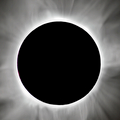
On this page: Intro | Interactive Map | Eclipse Diagram | Observations from April 8 | Eclipse on the Internet | Before the Eclipse: April 8 Outlook | The Sky during the Eclipse | Resources | Eclipse Preview on Everyday Spacer Livestrem | Eclipse Ohio | Viewing a Partial Eclipse
April 8 Eclipse Pages: Home (this page) | Resource Guide | Party Planning
Like Astra's on Facebook
On April 8, 2024, the path of a total solar eclipse (Saros 139) emerged from the Pacific Ocean and entered Mexico near Mazatlán. It reached greatest eclipse at Nazas, Mexico where it lasted for 4m 28s. It crossed into the State of Texas near Piedras Negras. It passed through Texas, just south of Dallas where folks could enjoy totality. The path crossed the lower eastern corner of Oklahoma, and moved through Arkansas somewhat north of Little Rock. It crossed the lower eastern corner of Missouri, entering Illinois near Carbondale, moving across the southern extreme of the state. Now the path crossed the middle of Indiana, where it encountered Indianapolis lasting for 3m 50s. Entering Ohio north of Dayton, the centerline passed just north of Cleveland, and entered Lake Erie. Then it hit the ground again, skimming across the northern extremes of the state of New York with Buffalo sitting right on the centerline. The path crossed Lake Ontario, returning to upper state New York where it crossed Lake Champlain. It moved into Vermont and went into Canada skipping over New Hampshire, though some totality was had in the northern extreme. The central path went through Maine in the U.S. and New Brunswick in Canada. The eclipse path plunged back into the ocean with 3m 15s of totality south of Pointe-Sapin-Centre. The centerline then again hit dirt at Newfoundland, plunging into the north Atlantic and stopping below Iceland, unable to make it to Europe.
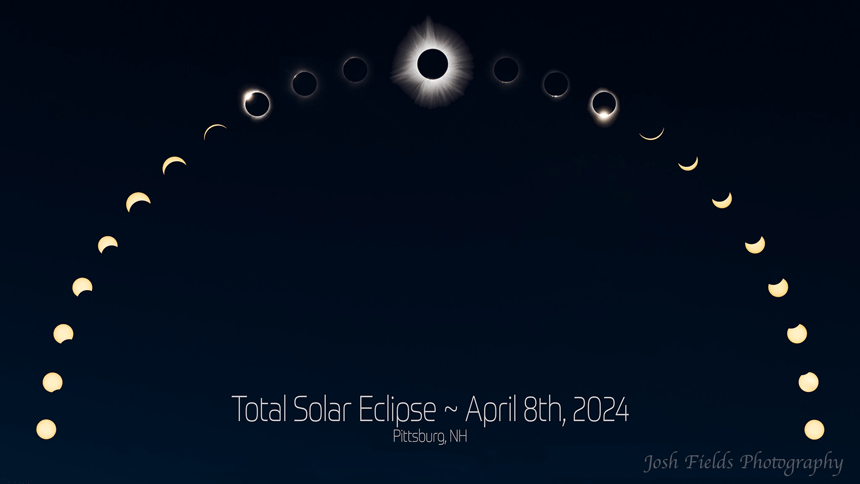
This eclipse went right over my hometown where it lasted for 3m 50s. Although it was likely that the weather would be lousy on April 8th, I made up my mind to hang out at home so I could see what there is to see in my neighborhood. I was not disappointed. There is a local section on this page that includes local conditions for the State of Ohio. Also check the Resource Guide for the April 8, 2024 Eclipse page to find more resources for Ohio.
Unfortunately, all over the United States of America across the eclipse track was very likely to be hosting cloudy skies. Often, major low pressure zones are acting up and it's thunderstorm season, while tornadoes have left definite footprints on the terrain in the U.S. during this early Spring season. The situation in Mexico was perhaps slightly better, but the terrain is mountainous. I considered taking a vacation in Mazatlán for the eclipse.
Everyone along the eclipse path experienced the darkness of totality. For some a miracle happened and a clear sky opened up on an otherwise cloudy day. We had high cirrus clouds in northeastern Ohio but they did not keep us from viewing the eclipse. The description above includes the major cities that are on the actual centerline where totality occurred regardless of the weather!
The 2024 Total Solar Eclipse interactive Google map depicted below was created and is maintained by Xavier Jubier. Xavier has many eclipse pages on the internet that he provides as free resources and does not include advertisers. If you like his work, consider giving him a donation. You will find more information on Mr. Jubier below.
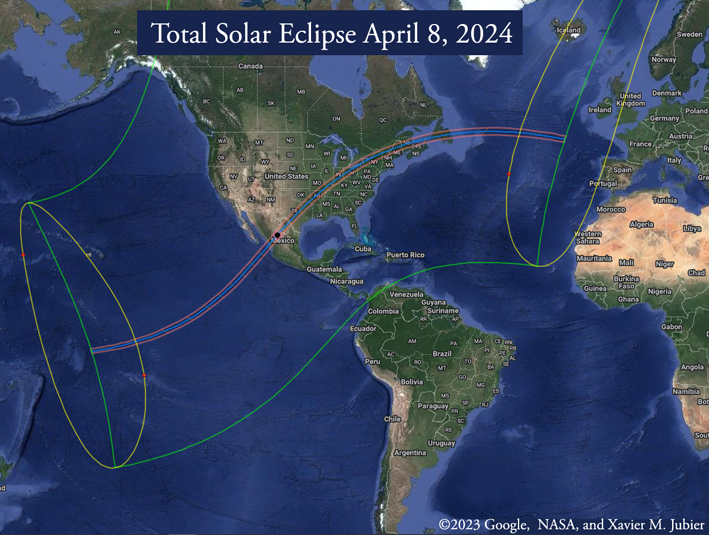
The web address for the interactive Google map is given below. It is fully functional and information at various locations can be gathered by zooming in on the map at your location. Why stop at the 2024 eclipse, why not try others? You can look up your home town or any other location you may be thinking of going when you are chasing an eclipse.

Mr. Eclipse a.k.a. Fred Espenak provides information for every eclipse that may be found on his website, EclipseWise.com. Eclipse diagrams can be very helpful. They can be printed out. Astra only has a single image here, because Mr. Eclipse allows his images to be used without charge as long as he is properly credited. As always, his website is one of the best places on the internet to find the numbers you need to plan eclipse chasing. You can also download a more detailed copy by following this link to the EclipseWise website
For this eclipse, the path of totality is 14,790 km or 9,190 miles long and 185-kilometer or 115-miles. The shadow of the moon moves through Mexico, fifteen U.S. states, and Canada. It traverses the continent of North America and ends its path in the Atlantic Ocean after passing over Newfoundland.
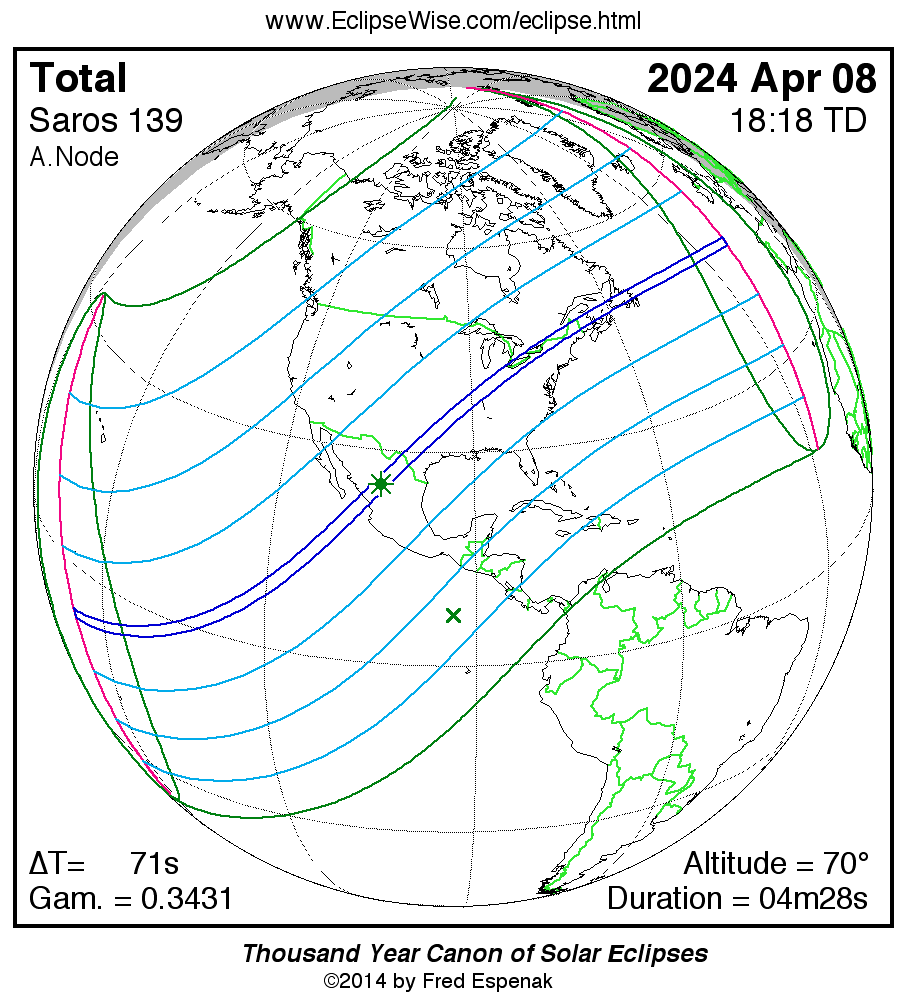

☆ ☆ ☆
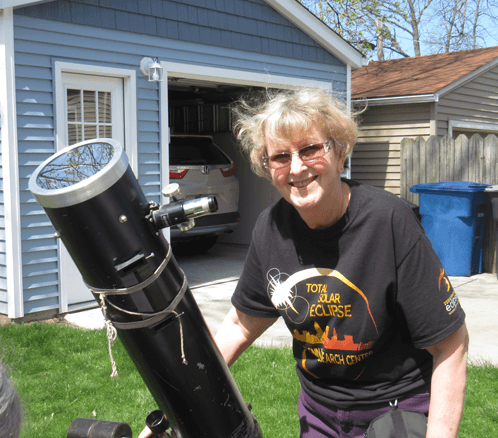
I observed the April 8, 2024 eclipse with my family from Cleveland, Ohio. Here I am with my trusty 6-inch telescope that has accompanied me through three solar eclipses and many lunars. I ground the mirror myself many years ago. In my biography, you can find a picture of me and my old friend at the solar eclipse we viewed in Baja California.
We decided that despite weather cautions, we wanted to see what there was to see from our backyard. The morning began as promised by the weather forecasters with rain in the morning. The sky began to clear around 10:30am. The entire eclipse had to be viewed through high cirrus clouds. We set up in the back yard to watch as first bite occurred, that was around 1:58 pm EDT local time. There were 3 clusters of sunspots that could be seen as the Moon moved across the Sun’s disk.
Our observing group included 13 family members. We used a 6" reflector with 32mm eyepiece and a full Thousand Oaks solar filter and a 3" refractor with 18mm eyepiece with 500 mm f/l Ceymore Solar filter. We mounted our 10 x 42 Celestron porro-EclipSmart binoculars on our sturdy tripod. We used viewers or "sunglasses" and small projection cameras as well as a larger box pinhole camera. We failed in our efforts to view the eclipse through kitchen utensils. We decided there were too many clouds to see the image properly with the larger holes in the utensils. Some views of the eclipsed Sun came through the holes in my straw hat at times.
It got cooler when the moon covered half of the Sun. In fact, the weather of the day surprised me. Weather called for 68 degrees and it was at least that. Not usual for early April. I wore only my tee-shirt all day and we needed our hats to keep us cool. As the sky was getting darker, little birds were flying about as if on their way home.
As totality approached, a magnificent 22-degree halo surrounded the eclipsed Sun. I absolutely love halos and go crazy photographing them when I see them. Birds flew toward their sleeping places. There was a flash of light from the Sun as a small patch of clear sky passed by quickly. Soon totality was upon us. It occurred around 3:13 pm just as had been predicted.
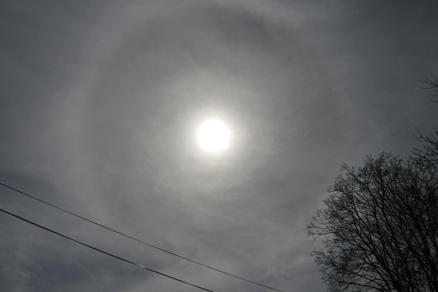
The Sun’s corona was blending in with the clouds. I found Jupiter in the sky but I don’t think I actually saw Venus myself. It was cloudy, after all. I tried to see comet 12P/Pons-Brooks, but there were just too many clouds. The view at the telescope was fantastic with giant prominences blasting on all four corners—at the poles and sides and many small red blobs around.
When I looked away from the telescope, I could see a prominence blaring red at the bottom of the disk with my naked eye. I looked around the horizon, where I could see between houses, I could see light all around from the non-eclipsed area at the horizon. I tried hard to take a picture of our group. It didn’t turn out well.
I was pointing my camera at the eclipse to ready a shot. Someone yelled, "Oh, it’s coming out!" I hit the shutter and got a cool diamond ring image.
I guess I watched the end of the eclipse through the camera viewer. I was zoomed in as the Moon exited the disk of the Sun. It was fun watching the eclipse together as a family. Soon after totality, squirrels were scurrying about the trees as if they had just gotten up for the day! I think the picture I took at the end of the eclipse is the best one I've ever taken. Unfortunately, it meant that the journey to totality had been realized.
I kept peeking in the telescope as the sunspots on the disk of the Sun were revealed in reverse order. First the last spots to disappear returned. Some spots that were near to the edge of the Sun earlier appeared sharper as they had moved toward the center of the disk. I did notice the ragged edge of the Moon in my telescope during this eclipse.
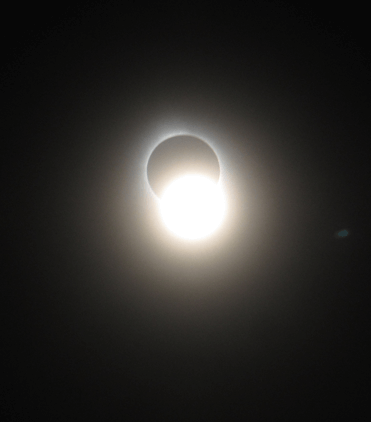
We moved our telescopes to a better vantage point so we could watch as the last contact approached. About 4:58 pm, I watched as the disk of the Moon egressed from the disk of the Sun. Soon, the Moon moved off the Sun’s disk and it was all over. The memory of the April 8, 2024 eclipse as seen from my backyard will stay with me forever.
☆ ☆ ☆
In this section, you will find images that were gathered from the internet. Please stay a while and enjoy them, but there are also a few links to some cool stuff about the total solar eclipse of April 8, 2024. First, and also helpful for this web page, Anton Petrov made a video for his YouTube Channel, Mind-Blowing Phenomena During 2024 Solar Eclipse. Anton also presented the eclipse on livestream that can be found at his channel. A local television station Channel 3 WKYC, produced a seven minute video as the city of Cleveland experienced an eclipse. Because of its length, and the fact that there is a telescopic image accompanying totality, I believe it is a good watch for anyone who was interested in seeing the effect of totality on a large modern city. The video is Solar eclipse in Northeast Ohio: Cleveland experiences totality. You may also like Day Turns to Night INSTANTLY | DRONE View | Total Solar Eclipse 2024 from Attractions 360° showing the eclipse from Houlton, Maine where the sky went dark for 3 mins 22 secs.
Josh Fields was kind enough to post his pictures on FaceBook and they used with permission. These are excellent images and the photo montage at the top of this page was also posted by Josh. Click on any of the images to visit Josh's 2024 Total Solar Eclipse page to purchase prints or visit Josh Fields Photography home page. Thanks to Josh for making these beautiful images and letting Astra's Stargate share them!
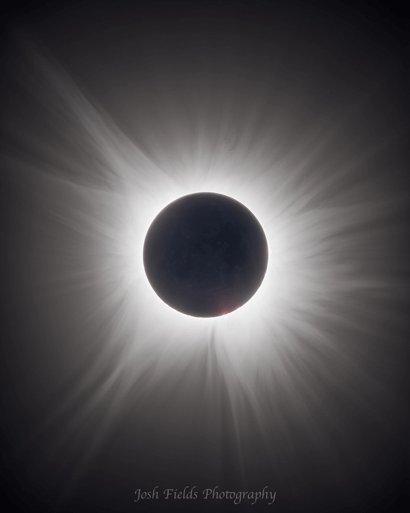
Josh Fields' image of the solar corona during totality is fantastic. The corona surrounds the Moon's silhouette when the Sun's disk is totally covered, otherwise it can't be visually observed from Earth. The word corona means crown, it extends from the Sun for millions of kilometers (miles). It appears like a white mist that surrounds the eclipsed solar disk. The solar corona is hotter than the Sun's surface as temperatures in the corona have been measured up to 10 million degrees Kelvin. In the corona, the solar flares reach out from the Sun’s disk and speed through the solar system. There were no flares on the day of the eclipse. The Sun is growing more active as it approaches solar maximum and in the weeks before the eclipse it was very active. It was probably just taking a break before the next flare up! The corona appears different during every total solar eclipse.
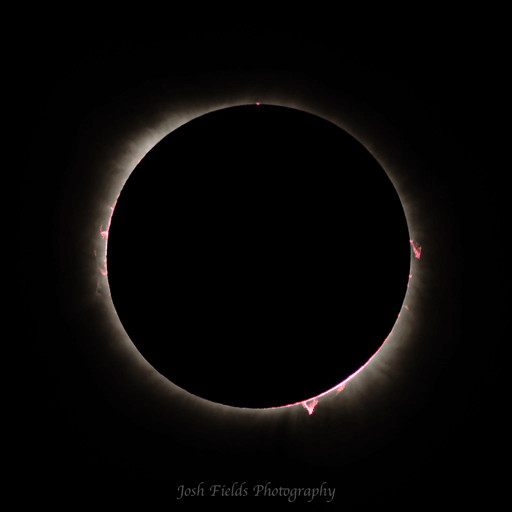
During totality prominences at the edge of the Sun's limb can be seen in Josh Fields' image. Solar prominences are loops of plasma that rise up from the surface and fall back again. Plasma is a hot gas made of electrically charged hydrogen and helium that flows along magnetic fields generated inside the Sun. The prominences appear a bright pink color in my 6-inch telescope. The bottom spike grew during the eclipse based on videos I have watched. There was a point during the eclipse when this prominence could be seen as a definite pink glow shining behind the light cirrus clouds that made this eclipse a fabulous experience for me.
We love this gorgeous image that Josh captured over a river. The blue of the sky seems accurate (to my memories) and the yellow light from the Sun can be seen at the horizon where the totality is not occurring. Venus appears below the Sun. The solar corona looks fantastic in this image.
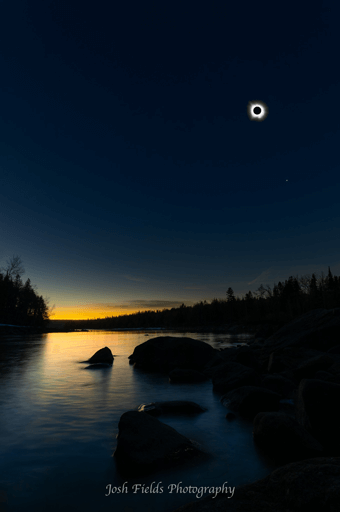
☆ ☆ ☆
About 1 million miles above Earth, NASA’s Deep Space Climate Observatory satellite (DSCOVR) captured the above video of Earth from 16:02 to 20:32 Universal Time or between 12:02 and 4:32 p.m. EDT with the Earth Polychromatic Imaging Camera (EPIC). DSCQVR is a joint NASA, NOAA, and U.S. Air Force satellite orbiting from Lagrange Point 1 between the Sun and Earth. This site can be found at Total Solar Eclipse Darkens North America at NASA Earth Observatory.
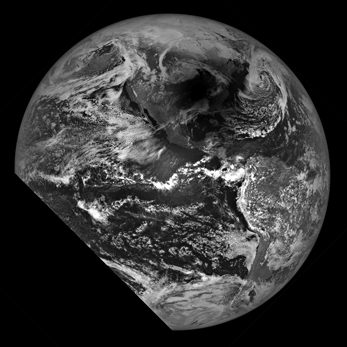
This image was taken by NASA’s Lunar Reconnaissance Orbiter, a satellite that has been orbiting the Moon since June of 2009. The image shows the Moon’s shadow on Earth’s surface. It was taken over a 20-second period starting at 2:59 p.m. EDT using the satellite's high resolution black and white camera. This means that it took the picture very close to totality from our observing site in Ohio. LRO's usual target is the lunar surface, but NASA found a way to take it away from its current task to snap a rare image. The image is credited to NASA/Goddard/Arizona State University.
SpaceX Starlink satellites also observed the eclipse from space. Seen below, the shadow of the Moon shows distinctly on the Earth moving along the Earth's curved surface. The video has been slowed for viewing ease.
This video is embedded from MechDesignTV on YouTube, originally posted on X from SpaceX. The video has been edited by MechDesignTV and can be viewed directly on their YouTube channel.
☆ ☆ ☆
Australian amateur Cliff Watson and Dawn Jenkins (aka Astra) guest starred on Everyday Spacer's livestream talking about the April 8, 2024 total solar eclipse on March 29/30. Dawn shares the April 8, 2024 total solar eclipse pages on her website, Astra's Stargate. This video provides information on the eclipse given by amateur astronomers. It includes an eclipse simulation using Stellarium planetarium open-source software (timestamp 21:40). Cliff Watson shows off his fantastic pictures taken during various eclipses. Jeff Miller talks about Eclipse Safety. Find the video on Everyday Spacer's YouTube channel.
Discover the pages of the April 2024 eclipse at Astra's Stargate and learn how to find some eclipse resources available on the internet.
The April 8, 2024 eclipse was fantastic, seen behind thin clouds or under clear skies across the US, Canada, and Mexico!
☆ ☆ ☆
If you are planning an Eclipse Party, check out our Party Planning page. Astra's Stargate has a coloring page for the young folks at your party. Download the PDF here:
☆ ☆ ☆
As the hours tick away before the April 8 eclipse, check the National Weather Service for updates on the weather. It looks dismal, but remember, you don't know if the clouds are really going to be over your head. Be prepared! You will find me in my backyard standing in the dark on Monday, April 8, during totality.
April 8, 2024 Solar Eclipse and Cloud Cover Forecasts - National Weather Service
The image below comes from the Eclipsophile website owned by Jay Anderson and Jennifer West. In addition to presenting in-depth coverage for solar eclipses, the images on the site are copyright free. So thank you to the folks at Eclipsophile! For their complete weather report on Eclipsophile, go to Total Solar Eclipse April 08, 2024
In this image, the grim picture of North America's weather on the day of the eclipse, April 8, shows not just one but two weather lows. It is early Spring and April is a month of transition. The red eclipse track threads itself through two different low pressure tracks, oh and then there is the fast moving track known as the Alberta Clipper, just another low on the eclipse centerline. The sky might be clear but don't count on it. Just remember, even if the sky is totally cloud covered you'll still see day turned into night during the eclipse. Just because the outlook is bleak, don't let that stop you from observing from your location.
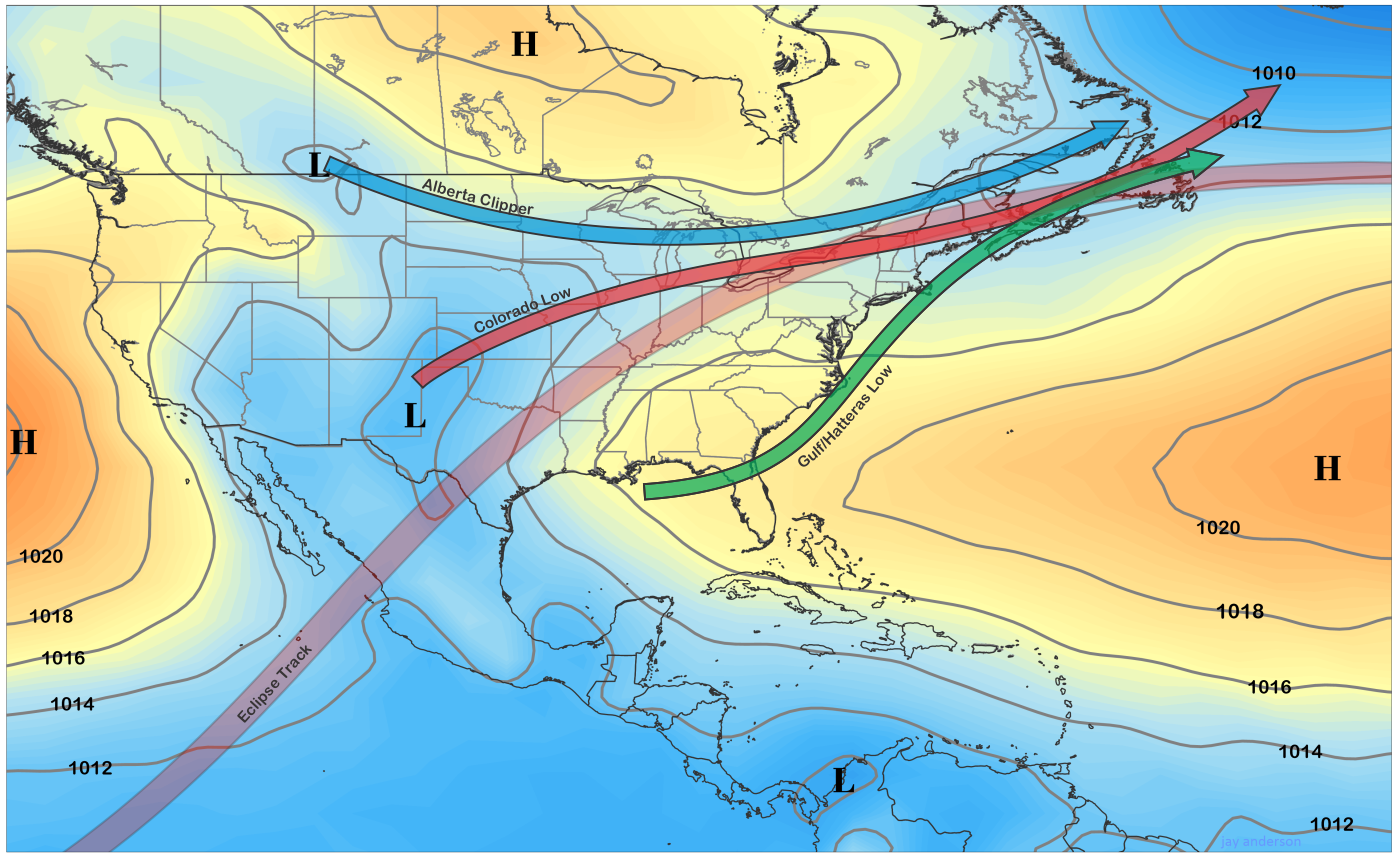
A very good resource for planning an eclipse trip in 2024 is Best Places to See the 2024 American Eclipse Based on Historical Weather Data at Sky Live. A nice table gives a quick overview of places to observe from. This site is also on the resources page. SkyLive covers the duration of totality and weather conditions, like mostly clear, partly cloudy, and mostly cloudy weather conditions by percentage for major cities along the 14,790 km or 9,190 mile long eclipse shadow path. Information such as is presented below can be derived from the page linked above.
In Mexico, when the eclipse touches the mainland at Mazatlán, the duration of totality is 4:22, and the maximum eclipse occurs in Naraz, where it lasts 4:29 and there is 52% chance of clear skies. Now the duration of totality slowly decreases. The eclipse path moves into the United States of America near Eagle Pass, Texas where the prediction states that there is a 33% possibility of cloudy skies. The state where the best possibilities occur are in Texas, but there is no guarantee anywhere. SkyLive gives the data for seventeen different cities in Texas. The duration of the eclipse in Indianapolis, Indiana is 3:51 and the possibility of a clear sky is set at 41%. As the eclipse enters Canada, the first location listed is Bellville, Ontario where the duration of totality is 2:04 with a 33% of clear sky.

The image below comes from the Stellarium planetarium program. It was programmed for northeastern Ohio, but these results will be similar in your own sky at the time of totality.
For this eclipse we are fortunate to be treated to the spectacle of a very nice periodic comet that is heading for its perihelion date with the Sun. Comet 12P/Pons-Brooks has been quite active so far for this visit to the inner solar system, a visit that occurs once every 71.3 years. Perhaps when the Moon covers the Sun completely, sharp eyes and cameras can spot the comet near Jupiter. Brighter, but closer to the horizon, Venus may also be seen.
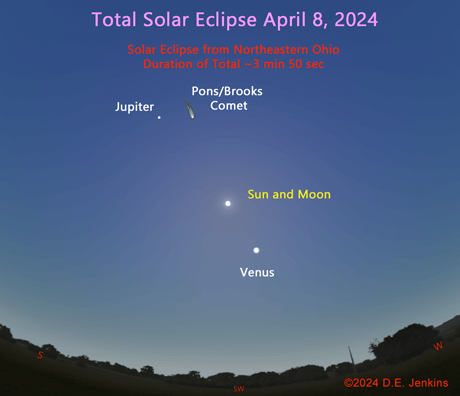
Enjoy these resources or go to our page dedicated to April 8, 2024 Solar Eclipse Resources that will be updated frequently until the eclipse occurs.
Total Solar Eclipse of 2024 Apr 08 - NASA Goddard Eclipse Map
Total Solar Eclipse of 2024 Apr 08 - EclipseWise by Fred Espenak
Solar Eclipse Across America - American Astronomical Society (AAS)
AAS provides a complete guide to the April 8, 2024, total solar eclipse. On this site educators can find printable handouts for their students. AAS also has an app called, Totality that gives detailed information about total solar eclipses. Find more information on the April 8, 2024 Eclipse Resources page.
Solar Eclipse Circumstances Calculator
Use this page from Fred Espenak to find the local circumstances for your home town.
2024 Eclipse Overview - from the National Eclipse website.
April 8, 2024 - Great North American Eclipse - from timeanddate.com
Total Solar Eclipse April 08, 2024 - Eclipsophile
Eclipsophile offers Climate and Weather for Celestial Events and can help eclipse chasers to decide where to go to view eclipses that are covered on the site.
Total solar eclipse of April 8, 2024 over Mexico, the USA, and Canada - from the Great American Eclipse website.
2024 April 8 Total Solar Eclipse in Mexico, the USA or Canada - by Xavier Jubier
Input your city into the search box to get local information
NASA's Scientific Visualization Studio presented the following animation along with some still photos that can be used for presentation by individuals because they are the property of the U.S. government. Presenting, the path of totality for the Total Solar Eclipse of April 8, 2024:


OK, right off the bat I'm going to tell you that the Great Lake of Erie is not frozen, as some will suggest when you look up local circumstances because they will be going by local weather history. The 2024 winter was fairly mild in northern Ohio, and an early Spring came even as the ground hog looked for her shadow. Last year on April 8, that is 2023, the sky was clear all day long. Does this mean we are guaranteed to see the Sun this year? Of course not, but don't give up on seeing something where you are in the continental U.S., there is a solar eclipse for everyone. You can view a partial eclipse using simple pinhole projection.
Back in 2017, for every state in the U.S. that was going to experience totality, I made an image like the Ohio state here. I haven't done that this time because the eclipse occurs all over North America, not just in the U.S. I couldn't resist doing Ohio for this eclipse because it's my home. Avon Lake, Ohio is the closest town that is on the centerline. More information on local resources can be found on the Resource Guide for the April 8, 2024 Eclipse page to get more information on local events.
A local television station, Channel 3 WKYC, produced a seven-minute video as the city of Cleveland experienced an eclipse. The video isSolar eclipse in Northeast Ohio: Cleveland experiences totality. A short video shows "Cleveland Cam" or TIME-LAPSE VIDEO | Watch downtown Cleveland go into totality during solar eclipse.
Data from the Google interactive map of the April 2024 Solar Eclipse- by Xavier Jubier
Avon Lake, OH
Avon Lake is located at 41° 30’ 19” N. 82 ° 1’ 42” W.
| Event (ΔT=69.1s) | Time (UT) | Altitude | Azimuth | P | V | LC |
|---|---|---|---|---|---|---|
| Start of partial eclipse (C1) | 17:58:54.8 | +55.5° | 192.8° | 231° | 04.6 | |
| Start of total eclipse (C2) | 19:13:17.7 | +49.1° | 221.4° | 052° | 11.3 | -0.6s |
| Maximum eclipse (MAX) | 19:15:14.2 | +48.8° | 222.0° | 322° | 02.3 | |
| End of total eclipse (C3) | 19:17:10.4 | +48.6° | 222.6° | 232° | 05.3 | +0.0s |
| End of partial eclipse (C4) | 20:28:38.6 | +38.0° | 242.2° | 054° | 11.6 |

So what do you do if you aren't on the centerline? If you are located in the United States, or even if you are in Mexico or Canada, and you can't get to the centerline, that doesn't mean you can't see this solar eclipse for yourself. Let's say that we are in Denver, Colorado. Using the Google interactive map of the April 2024 Solar Eclipse provided by Xavier Jubier, put the location "Denver, Colorado" into the search box. The map will resize and the display the results for Denver, Colorado in the middle of the screen. As is seen here:
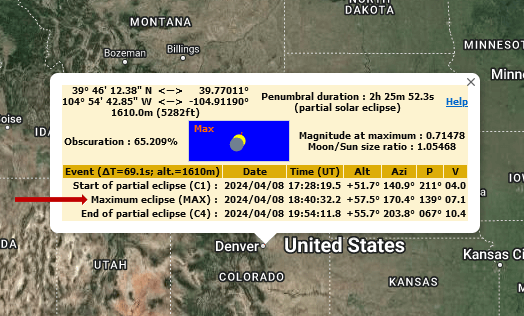
Move your cursor to the line of the pop-up table that says, "maximum eclipse". (Marked in the image by a red arrow.) The table changes a little to read, greatest obscuration 65.209%. When the Sun is covered by the maximum extent of the Moon's disk in Denver, it will be 18:40 UT or 12:40pm. There will be a partial eclipse that lasts 2 hours and 25 minutes. During the time of the eclipse, you can use a simple projection camera to watch as the Moon's disk touches the Sun and track it as it moves across the disk until the eclipse is over. Do not look at the Sun unprotected. You can use any method of viewing as long as you and your eyes are protected. Don't take chances - - read our Eclipse Safety page.
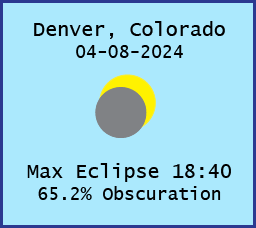
Here is Astra's representation of what you will see in Denver, Colorado at maximum eclipse based on the interactive Google calendar.

| Greatest Eclipse | Greatest Duration |
|---|---|
|
Lat. 25° 17’ N Long. 104° 8.3’ W Duration 4m 28.1s |
Lat. 25° 55’ N Long. 103° 31’ W Duration 4m 28.2s |
Thanks to Xavier M. Jubier and Google we have this fine service.
Additional 2024 Eclipse Resources are available.
Planning a Party? Check out the 2024 Eclipse Party guide.
April 8 Eclipse Pages: Home (this page) | Resource Guide | Party Planning
Last Modified: 05/02/2024